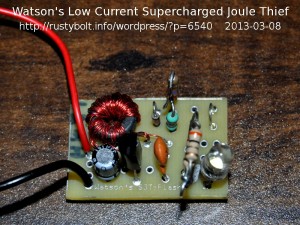 I told Paul about my Supercharged Joule Thief but he had doubts about it having lower current consumption than a conventional Joule Thief. Originally I had set the value of the resistor to give the optimum current through the LED, and it was about 1.5k, which was good for about 20 mA LED current. But I had not tried to go lower than that when I experimented with the circuit. I decided to try changing the value of the resistor to a higher value to see if the circuit was still better than the conventional JT.
I told Paul about my Supercharged Joule Thief but he had doubts about it having lower current consumption than a conventional Joule Thief. Originally I had set the value of the resistor to give the optimum current through the LED, and it was about 1.5k, which was good for about 20 mA LED current. But I had not tried to go lower than that when I experimented with the circuit. I decided to try changing the value of the resistor to a higher value to see if the circuit was still better than the conventional JT.
I used my Supercharged JT Flasher board but with the flasher parts replaced with a jumper (see attached photo). This turned the circuit into a Supercharged JT. I put a 10k pot in series with the resistor but left everything else alone. The diode was a standard 1N4148 and the original resistor was 1k. The LED was a white one. The capacitor was a 1000 pF ceramic disk. The transistor was a TN3019A, a plastic equivalent of 2N3019A. It’s similar to the 2N2222A but higher power. I put a 1 ohm resistor in series with the cathode of the LED to allow me to measure the LED current.
I applied 1.5V, and I adjusted the supply current for 25 milliamps. When I measured the LED current I got 9.4 milliamps, which was about half of the optimum LED current I try to get to the LED. I removed power and measured the pot, and found that it was set at 2650 ohms. I removed the pot and soldered a 2.7k resistor in series with the existing resistor for a total resistance of 3700 ohms. I applied power and checked the supply current at 1.5V and it was still 25 mA. I measured the voltage across the 1 ohm resistor and it was 9.4 millivolts which was the same as 9.4 milliamps.
Thus the efficiency is 3.3V x 0.0094A divided by 1.5V x 0.025A. My calculations showed that this was 82.72 percent efficient, which is a lot better than a conventional JT. I did not try to optimize the circuit for the lower current, but I think I could have tweaked it a bit to improve it somewhat. The Supercharged Joule Thief circuit is a solid performer, and better than the conventional Joule Thief (see my comparisons here).